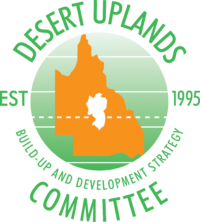OUR DESERT UPLANDS BUILD-UP AND DEVELOPMENT STRATEGY COMMITTEE, now commonly known as the Desert Uplands Committee or DUC came into being in the late 1990’s. Thirty years ago, challenges with long-term successful livestock grazing enterprises within this variable climate and its frequent droughts, whilst stewarding the intact biodiverse wooded desert ecologies, galvanised proactive landholders to form the Committee.
With the Aramac Landcare Group forming in the early stages of the Australian Landcare movement, its founding members saw the value in a larger collective linking landholders across the sandy timbered country that stretches up to near Charters Towers. Developed as a planning tool by the Australian government in 1993–94 and published in 1995, the Interim Biogeographic Regionalisation for Australia (IBRA) had recently defined and mapped the Desert Uplands Bioregion. In 1994, the Aramac Landcare group applied to extend a scheme initiated by the South West Strategy, the Mulga Land Degradation Voluntary Property Build-Up Scheme, to the Desert Uplands region. The Desert Uplands Build-Up and Development Strategy Committee was established in 1995, constituted in 1997, with its initial focus on a lack of relevant research of the region’s ecologies and grazing issues, high debt levels and general agency disregard.
The Committee met across the region, garnered departmental interest, and collaboratively and voluntarily conceived, developed and implemented targeted projects and schemes across the bioregion’s grazing properties. The exemplary Enterprise Reconstruction Scheme and the DU Strategic Land Resource Assessment mapping were followed by the Long Term Carrying Capacity Project. The federal Natural Heritage Trust was a key facilitator of these innovative approaches to improving grazing land management, ecological preservation, and enterprise and community betterment.
The 2002 federal Regional Bodies Process divided the Desert Uplands Bioregion eight million hectares vertically with the Great Barrier Reef catchment on the east going into North Queensland Dry Tropics, and the western side’s Lake Eyre catchment into Desert Channels Queensland, with a small north-west portion that drains into the Gulf being Southern Gulf Catchments NRM.
Now with near three decades of experience, the Committee continues to lead the way in developing and implementing rangeland programmes through strong landholder engagement and a voluntary, grassroots, not-for-profit organisation. Meeting regularly in person and digitally, the Committee in addressing economic, environmental and social issues pertinent to our Bioregion, continues to strengthen and broaden its collaborative networks, linkages and resourcing options, whilst actively facilitating extension and knowledge brokering in these erratic and challenging times.
OUR MOTTO is Delivering Community Solutions for Regional Issues
